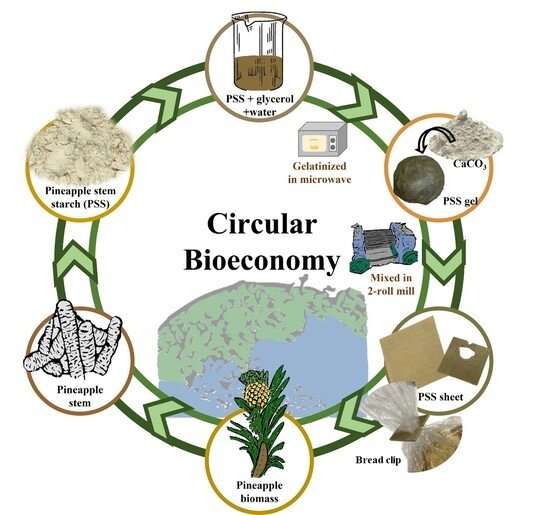This article has been reviewed according to Science X's editorial process and policies. Editors have highlighted the following attributes while ensuring the content's credibility:
fact-checked
proofread
Researchers make bioplastic sheets with pineapple stems from agricultural waste

A team of researchers from universities in Thailand and Malaysia have collaborated to develop a unique kind of bioplastic sheet that is good for the environment and can decompose naturally. They made this bioplastic sheet using a byproduct of the bromelain industry which used the leftover pineapple stems from agricultural waste. This new type of bioplastic sheet has the potential to be used as single-use packaging material, as an alternative to the use of harmful plastic sheet, contributing to a more sustainable way of doing business and promoting a circular economy. The research is published in the journal Polymers.
Plastic waste is a big problem for the environment, especially small plastics like bread clips that are hard to recycle or dispose of, and could negatively affect living organisms. Proposed solutions include the use of biodegradable polymers for single-use applications and the implementation of plastic bans in certain countries.
Biodegradable polymers encompass a range of options, such as fully biobased polylactic acid (PLA), partially biobased polybutylene succinate (PBS), fully synthetic polybutylene adipate terephthalate (PBAT), as well as natural polymers like starch, polyhydroxyalkanoates (PHAs),and polyhydroxybutyrate (PHB). However, it is crucial to recognize that not all biodegradable polymers possess the same characteristics, and it is essential to understand the specific properties and limitations associated with each type.
For instance, widely employed biodegradable polymers such as PLA, PBAT, and PBS do not readily biodegrade under natural environmental conditions, necessitating specific conditions such as controlled humidity and temperature typically found in industrial composting facilities.
Therefore, it remains imperative to ensure the proper disposal and collection of these biodegradable materials in such facilities to guarantee their complete degradation. In contrast, starch-based materials, PHAs, and PHBs are fully biodegradable within natural environments, presenting a potentially suitable choice for certain applications where convenient collection and recycling prove challenging or economically unviable. These materials possess the ability to biodegrade entirely without requiring specialized industrial composting facilities, thereby offering a more practical and environmentally friendly solution for specific waste types.
To tackle this issue using starch-based materials, the team used the starch from the pineapple stems as the main ingredient. They added glycerol and calcium carbonate to make the material easy to shape and strong. By altering the amounts of these ingredients, the team made samples with different strengths and properties.
The resulting material could resist water and didn't soak up as much water as other similar materials. When the team buried it in the soil, it completely broke down into tiny pieces in just two weeks. The team even made a test version of a bread clip using this material, and it worked well in holding a bag closed. This study shows that using pineapple stem starch can be a good and eco-friendly choice instead of using plastics made from petroleum or other plant materials. It's a step toward a more sustainable way of making small plastic products and promoting a circular economy.
More information: Chanaporn Thongphang et al, Toward a Circular Bioeconomy: Development of Pineapple Stem Starch Composite as a Plastic-Sheet Substitute for Single-Use Applications, Polymers (2023). DOI: 10.3390/polym15102388
Provided by Newcastle University in Singapore





















